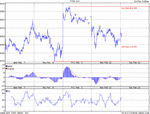new_trader
Legendary member
- Messages
- 6,770
- Likes
- 1,656
smccreedy said:I'm afraid that view is a little simplistic as many markets have individual traits that will make them behave differently. Your assertion that everyone is investing in a direction to make profit is simply not true in all cases. Take for one the case of central banks defending key areas in FX for political reasons rather than trading reasons.
Think over some of these too:
The DJIA has only 30 stocks compared to the S&P500 and FTSE100 that of course makes it more volatile to the moves on one or two companies.
The DJIA isn't opened or closed by auction like the FTSE but using SOQ that places a value of the open after it's opened buy looking at prices after the first five mins of trade. The same on the close, it isn't an equilibrium like the FTSE of buyers and sellers it's a formula for what prices stocks traded at. This sounds fussy but does make a difference to how you read the data compared to say FTSE open and close figures.
FX trades nearly 24/7 as such strategy would have to take into account these extended hours.
FX also is needed in the real world, unlike say Vodafone stock so certain transactions have to take place regardless of price. Some participants aren't there to predict price direction but to hedge real world needs, these leads to what you might call non-rational traders which you don't have in stocks as generally people buying stock expect it to go up, sellers expect it to go down.
Commodities too are bought or sold to respond to real world needs rather than pure speculation / investment which makes them behave differently.
The notion of limit up and limit down in commodities would make a good stock strategy useless for them.
Some stocks are played by day traders which might make and end of day reversal as winners book profits to go home flat more likely or smaller stocks that are open to manipulation from the floor 'trying to hit stops' that is less seen in larger harder to move stocks.
This example cracks me up! Some US traders even now still see going short as unpatriotic and definitely impacts action there during wars and disasters more than it would in the UK.
Small emerging markets are moved by there lame currency than we are by move in the £.
Oil producing markets move more in line with the oil price and are probably best traded off that than there own merit.
Margin and open interest reporting and limitations in some markets impact some markets more and options expiry are much bigger deals in some markets ie gold than they are to say the FTSE.
When stocks on DJIA go ex dividend the index is repriced to take this in to account so after the dividend is paid the index and stock remain the same price. In the FTSE ex divs can knock up to 20 points a week of the index during Bank dividend season. This partly accounts for the apparent out performance of the DJIA over the years in % terms.
All these small differences give different volatility profiles in different ways in different times and give the need for different tactics at times.
It isn't fair to say that because one size doesn't fit all it isn't workable.
Stephen McCreedy
A simple trading system doesn't need to include any of the above. That is my point. This system you put forward is a simple breakout strategy but now you are introducing degrees of complexity to make it work.


